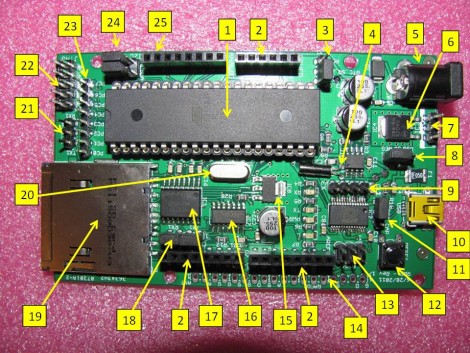
[Erik] wrote in letting us know that he just completed development of the Bobuino, a Arduino based on an ATmega1284. That chip is nice and beefy, most notably for having 16 KB of SRAM but it also boasts 4 KB of EEPROM, and 128 KB of program memory.
But the upgraded chip isn’t the only thing that it brings to the table. It’s easy to spot the on-board SD card slot in the image above. Also of note is the battery-backed DS1307 real time clock with a jumper that will route the square wave output to one of two pins on the microcontroller.
This design is compatible with standard Arduino shields thanks to the familiar pair of pin sockets, and can still be programmed via the USB socket. Since the AVR chip has more IO than normal there’s also pin headers to break out the PORTC pins, for a JTAG connector, and for an RS232 port.














arduino lust!
Very nice! Is it compatible with the Arduino IDE, with some file modifications? Or just AVRdude and the AVR Studio?
Tons of SRAM, an RTC AND an SDCard slot. Just what I need for a current project. $80 though… :/
Arduino UNO: $30
SD shield with headers: $16
RTC chip: $2
You are at almost $50 without the extra IO, extra RAM, EEPROM and FLASH, 2 UARTS (one with real RS232 levels).
$80 seems to be quite a bargain.
Teensy – $16
micro SD adapter – $8
RTC chip – $2
total $26.
Don’t get me wrong. $80 for a professionally made board like this is not so bad. I can’t justify $80 for one, as I can build it for a lot less (yes I have plenty of time ATM).
I can’t find the 1284 in my usual stores, but the 1281 seems like the closest is about $15 here, then add about $10-15 for the rest of the IC’s and plugs etc (not including the FTDI chip as I use a handmade cable anyway).
>16. 74AC125 3.3V driver chip to convert ATMega SPI pins to 3.3V. D30 (PD4) is dedicated to the SD socket chip select.
^^ I think this is probably a mistake, hardwiring the CS to pin4 instead of SS_PIN (or using a jumper selector). I know that some sheilds use pin4 as standard instead of the SS_PIN (pin 10), but that also means you have a pin in the middle of your block doing CS work, when you may want to access that whole block with parallel bitwise math (as I do on a current project).
arduino buono uno r3 (knock off) $8
sd card reader $2
I/O expander $2
ebay is the cheeper way to go plus the buono r3 supplies up to a 2 amp I/O output vs the standard .5A
Oooo…
You’re.. to sexy for by bus..
too sexy for my bus..
sooo sexy such luuust! :)
Tweeks
p.s. So DOES it work with the IDE?
Hi,
This is CrossRoads, the “Bobuino” is my design, all of its features can be see at
http://www.crossroadsfencing.com/BobuinoRev17.
I would like to thank Erik for writing in about it.
It is fully IDE compatible, I deliver the bootloaded board with several working Arduino-0022 sketches that I use to check them out prior to shipping and the modified pin mapping files for regular sketches and the SdFat library for the SD socket.
The shield breaks out the usual D0-D13 & A0-A5/D14-D19 that you would find on a Duemilanove, plus the IO continues with D20-D31.
I wanted a board that had the features of a Duemilanove with several additional features, and also took the suggestions of fellow Arduino-ites to flesh out the design.
So – dual Serial IO, real RS232 driver, battery-backed RTC (CR2032 battery holder on the back), SD socket. Jumpers for: power selection, Reset enable, D18/D19 or SCL/SDA going to the shield, RTC square wave output to a hardware interrupt pin or to a regular pin, 2nd serial going thru RS232 driver, or disconneced for use as D2/D3 on the shield.
$80 includes USPS flatrate shipping to your US location, international a bit more.
For what it is, the price isn’t bad…the only issue I see is that it is far more than what is needed for most small projects, and it isn’t enough for big projects and stuff that needs lots of processor power. Well, that and a pin layout that prevents you from making shields from project boards…that is why my arduinos are gathering dust; I can’t make shields for them, so I don’t have shields for them.
I made my own arduino on stripboard, and declined to use the strange spacing between the two headers (which was a mistake on the arduino team’s part which they decided not to rectify since), so for me it means it’s easier build my own shields (suits me) on stripboard or perfboard.
BTW it is possible to use manufactured arduinos with hand-fabricated shields (and vice-versa) you just need to create a little offset jumper plug adapter.
@KillerBug – If you are still waiting to get into Arduinos because of the header issue, wait no longer! Dust off that Arduino and sell it on eBay, then buy a Seeeduino v2.21. The SeeedStudio team have solved that header problem:
http://www.seeedstudio.com/depot/seeeduino-v221-atmega-328p-p-669.html
They also have a Mega version if you need more power:
http://www.seeedstudio.com/depot/seeeduino-mega-p-717.html
Sweeeet.